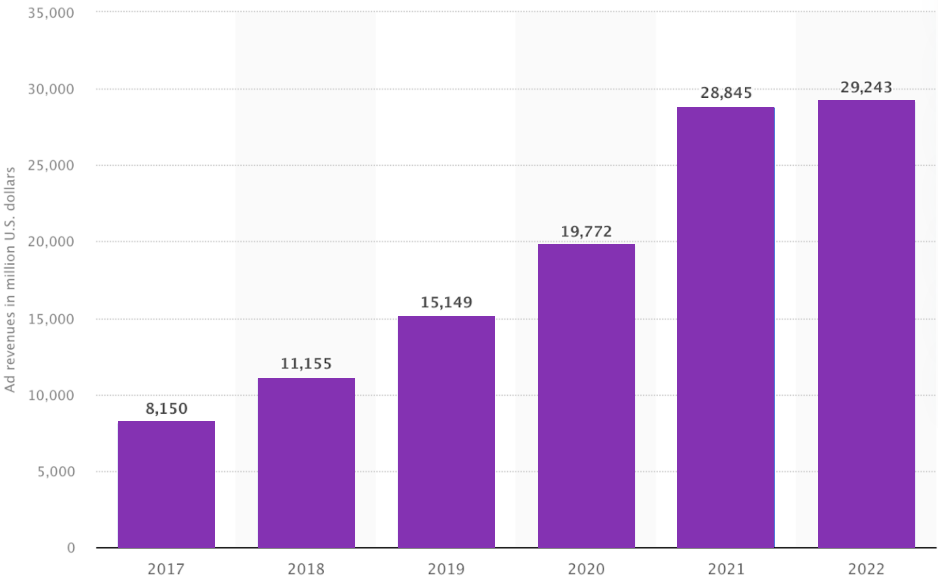By Eric Berman
Contributed to by Riley Wallace
As a marketer and agency guy who has been around long enough to remember running ad campaigns in the pre-digital era – buying GRPs on TV and Radio, and hoping for the best – I just love YouTube as an advertising platform. YouTube is the second largest social ad platform after Facebook, earning almost $30B in global ad revenue in 2022, and I still don’t think it gets the respect it deserves.
Worldwide advertising revenues of YouTube from 2017 to 2022 (in million U.S. dollars)

Here are four reasons I think YouTube ads generally deliver excellent value to brands, with a lens on kids and toy products.
1) Awareness
To gain awareness, you need reach. YouTube provides incredible reach for almost any audience. In terms of Monthly Active Users, it ranks just behind Facebook, with over 2.5B MAUs.
Most popular social networks woldwide as of January 2023, ranked by number of monthly active users (in millions)

62% of internet users in the USA access youtube daily. And 92% visit YouTube Weekly. (Data from Statista 2022).

© Statista 2022
If there’s a more efficient way to drive measurable awareness for a company or product, I’m not aware of it. As a performance marketing agency, most of our clients are mainly concerned with revenue and ROI, which is not what YouTube excels at. (People on youtube are not typically in shopping mode. They’re deliberately watching something they chose, and are less likely to click out of the platform because an ad interrupted them.) BUT if we begin a campaign with YouTube video ads where our objective is awareness, then we are “greasing the skids” (helping matters run smoothly) for later. We’ll ultimately see better performance from our sales oriented channels (search, social and amazon) when we shift objectives from awareness, to sales or conversions. Using youtube to familiarize your audience with your brand is a great strategy to deploy when launching a new product. Video viewers (except children) can also be captured and remarketed to later as we move down the conversion funnel with our tactics.
2) Recall
American children are watching YouTube far more than any other video platform, and it has proven to outperform conventional television when it comes to brand recall. A recent study shows that 70% of kids under 12 will recall a (contextually targeted) ad on YouTube, compared to 35% on broadcast TV.
Children are twice as likely to recall an ad on YouTube vs. any other platform.
In comparison to gaming and other platforms, YouTube delivers more brand awareness due to its greater commercial reach

With kids driving more of the purchase decisions around toys and products for them, the ability to reach kids and parents on youtube with a memorable advertisement is extremely valuable.
3) TrueView ad format
This one is no secret to video marketers but it always gets a reaction from clients when pitching our media plans: Advertisers using youtube’s TrueView in-stream ad format (common skippable pre-roll and mid-roll video ads) are only charged when a viewer watches at least 30 seconds of the video, the entire video, or engages with the ad by clicking a link. This means that if your ad is viewed for any amount of time under 30 seconds, that’s a free impression for your brand, and a high quality one at that. If 25% of viewers watch the whole video ad (the data varies, but a YouTube benchmark is 25%-30% VTR) it means that for every ad view, three additional views of at least 5 seconds were registered, and it didn’t cost the advertiser anything. We generally see CPV rates of $0.01-$0.03 for our campaigns, and combined with unpaid impressions, this delivers high quality, targeted (even if only contextual) engagement for video ads at a low CPM.
% of YouTube ad video views coming from TV screens
Device video view trend

Also, we should consider the co-viewing benefits of YT ads, where we capture an even wider targeted audience when families are watching YT together. This is a common occurrence where users are streaming from their devices to their TVs / Home Theatre. YouTube also provides advertisers the ability to serve ads only to big screens (because it knows if you are streaming or what device is being used to watch the ads). For brands with high quality produced content, it delivers a targeted broadcast commercial spot experience for the user, for a fraction of the cost to the advertiser.
4) Targeting
YouTube offers advertisers a wide range of audience targeting methods. For many brands, personalized advertising strategies including the use of remarketing and/or in market audiences can be quite effective, however in the toy space, contextual advertising must be prioritized to remain compliant & effective during ad campaigns. Examples of contextual-focused targeting methods include:
-Topics: Selecting topics to show ads on content about specific subjects (ex: stuffed animals)
-Video Lineups: Using pre-defined YouTube segments to reach high-profile channels/videos across YouTube relevant to certain themes (ex: Toy Unboxing & Reviews)
-Placements: A highly-targeted strategy offering brands the most control, where ad placements are limited to channels/videos benign selected during campaign creation.

